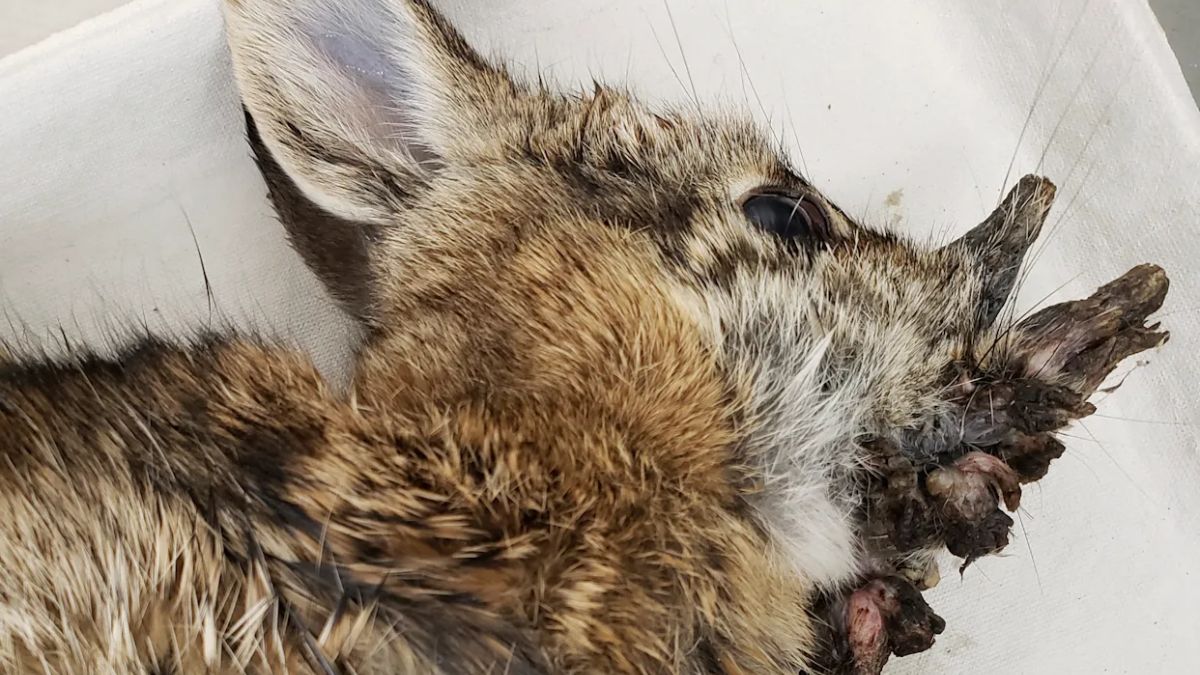No, it’s not science fiction. And no, it’s not AI-generated horror. What’s happening in Colorado is very real—and very strange. Locals have reported spotting wild rabbits with bizarre growths, some so large and deformed they’ve been compared to monsters or mythical creatures. People are calling them “Frankenstein rabbits,” and while the name sounds like a joke, the condition behind it is anything but.
So, what exactly is happening to these rabbits? Let’s break it down.
Virus
The bizarre growths are caused by something known as cottontail rabbit papillomavirus (CRPV), or Shope papilloma virus. It’s a virus that infects rabbits, leading to dark, horn-like tumors—usually around the head, neck, and mouth.
CRPV spreads mainly through insect bites, especially from fleas and ticks, and tends to pop up more during warmer months. Some of these tumors get so big that the rabbits can’t even eat, which leads to starvation. It’s a heartbreaking, slow way to go for an infected animal.
And yes—those “tentacles,” “black beards,” or “spines” you’ve seen in photos? They’re tumors.
Spread
Although the current outbreak is getting attention in Colorado, it’s not a brand-new phenomenon. In fact, cases have been recorded in the American Midwest, including a viral video in Minnesota back in 2013 showing a rabbit with antler-like growths. That sparked comparisons to the Jackalope, a mythical creature that’s basically a rabbit with antlers.
In Fort Collins, one woman claimed she saw a rabbit with “black sticks” growing from its mouth, and incredibly, the same rabbit came back a year later—still alive, but with even larger tumors.
Risk
Here’s the good news: CRPV poses no risk to humans or other pets. So you don’t need to worry about catching it from a wild rabbit in your backyard.
But if you have domestic rabbits, it’s a different story.
The virus can be much more severe in pet rabbits. It has the potential to develop into squamous cell carcinoma, a dangerous form of skin cancer. That’s why it’s absolutely crucial to keep domestic rabbits away from wild ones, and avoid areas where fleas, ticks, and other biting insects are common.
Symptoms
Here’s how to recognize a rabbit infected with CRPV:
| Symptom | Description |
|---|---|
| Horn-like growths | Usually dark, firm, and oddly shaped |
| Location of tumors | Around face, neck, and mouth |
| Difficulty eating or grooming | Caused by tumor size |
| Weight loss or weakness | Often due to starvation |
If you spot a wild rabbit showing these signs, don’t touch it. Call your local wildlife authority instead.
Prevention
There’s no known cure for CRPV, but there are ways to prevent the spread, especially to pet rabbits. Here’s what experts recommend:
- Keep domestic rabbits indoors or in controlled outdoor environments.
- Avoid areas with lots of insects, especially in warm months.
- Do not allow contact between domestic and wild rabbits.
- Use flea and tick prevention under your vet’s guidance.
If a domestic rabbit gets infected, surgical removal of the tumors may be an option, but it’s not a guaranteed fix. The virus can still return.
Impact
What makes this outbreak so disturbing isn’t just the science—it’s the visual impact. These animals look like something out of a dystopian movie, and that’s why people are reacting so strongly online. But behind the viral photos are real animals suffering, often slowly and silently.
It’s a powerful reminder of how diseases can affect not only populations, but also public perception and emotion. The Frankenstein rabbits have become an internet sensation, but at the heart of it is a serious wildlife health issue.
Let’s hope that with awareness and care, we can protect both wild and domestic animals from this strange and tragic condition.
FAQs
What causes the rabbit growths?
A virus called CRPV, spread by insects like ticks and fleas.
Can CRPV affect humans?
No, it poses no risk to humans or other pets.
Are domestic rabbits at risk?
Yes, especially if exposed to infected wild rabbits or insects.
Is there a cure for CRPV?
No cure exists, but surgery can help manage the tumors.
Where are these rabbits found?
Mostly in Colorado, but also other Midwest U.S. states.























